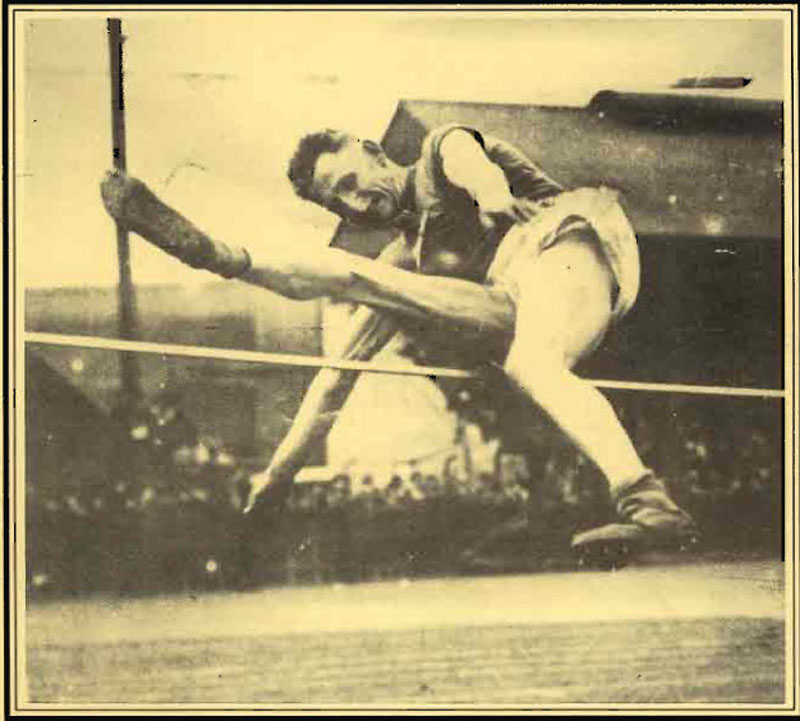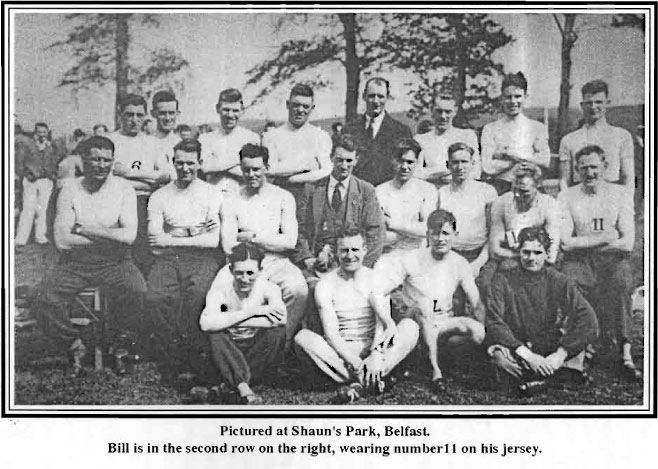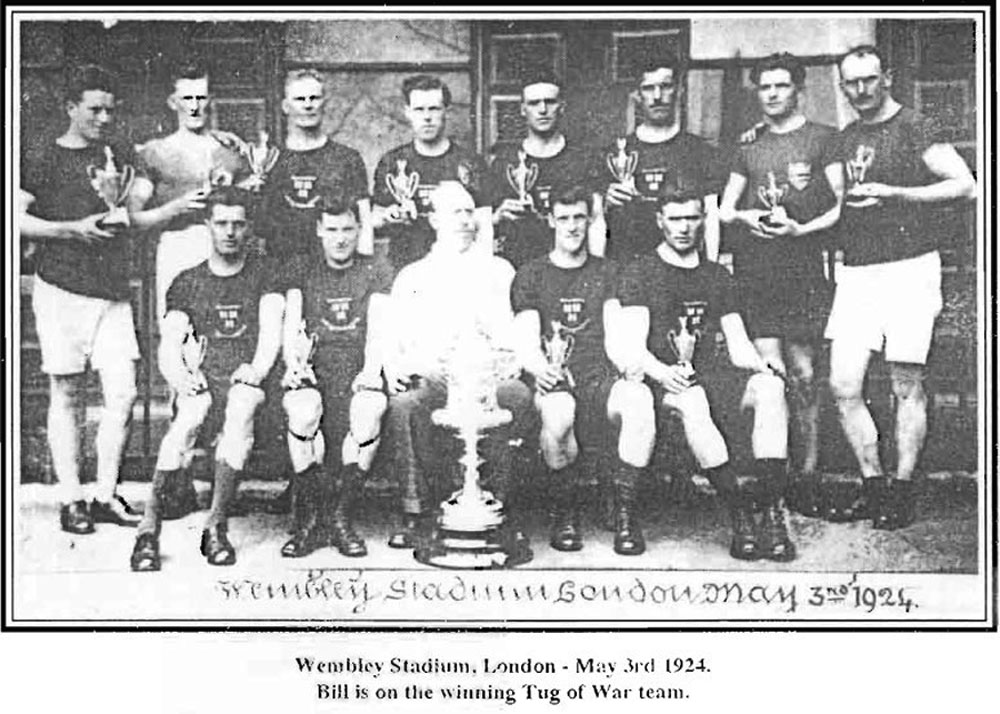Bill Shanahan
Outstanding all-round Irish Athlete of all time.
Hero and winner of Scott’s Medal for Bravery
COMPILED BY MARTIN O’DWYER – BOB
This is my small tribute to a famous Tipperary man (Bill Shanahan) who became a legend in his own lifetime
Irishmen generally, have always had a particular leaning towards the all-round athlete, for in the sphere of versatility the wearers of the green of other generations have won world renown, and Bill Shanahan was of this distinct type, now fast fading from the sporting scene, who invariably took part in upwards of half the events on the programme: his strength and spring, coupled with a fine turn of speed and uncommon durability, placing him on a pedestal as the outstanding Irish all-rounder of his time.
Bill was born in 1897 in Kilkarney, Ballinure, and Thurles. He loved jumping. It came like a second nature to him – as natural as walking. He was jumping since he was a kid. There was athletic blood in his veins and he was still going strong when he retired from active competitive athletics in 1928 at the age of 31. His parents were Tom and Mary (nee O’Grady) Shanahan. Mary was sister of Tom O’Grady known as the “Captain”. Bill and his brother Tom went to Noan National School which was built in 1843 at a cost of £60 by the Armitages who looked after its upkeep until it was taken over by the church.
The old school was replaced by a new building a number of years ago. Bill and Josephine Bulfin were classmates and childhood sweethearts and Josephine later became his wife She April 20th. 1940 and is buried in Ballinure.
Bill was a member of the l.R.A. and was in the National Army before joining the D.M.P (Dublin Metropolitan Police) in 1923 He was stationed at College Street station where he served until 1934 He was then transferred to the Detective Branch.
His uncle, Captain Tom O’Grady lived at Archerstown, Thurles, and was a fine athlete in his day. It was he who captained the victorious Tipperary hurling team who toured America in 1888.
He played with Two-Mile Borris selection for the Cuffe Shield in 1914, which they won. His brother Tom, born in 1895 and died on 8th May 1948, played with Boherlahan and was with them when they won the 1916 All Ireland , the Munster Senior Hurling Championship in 1916-17, All Ireland Junior Hurling Championship in 1913 and 1915 and in 1917 when they lost to Dublin. He feared nothing and hurled with a dash and spirit typical of Tipperary at its best. Bill had no back-up like sponsorship through media or otherwise and it was from sheer hard work on his father’s farm, and his spare time was taken up with strenuous endeavours and diligent practice to become a good jumper – but there was nobody to give the enthusiastic lad a wrinkle or tip as to the true art or skill of jumping . It was with the enduring effort both physically and mentally that sportsmen achieved their ultimate goal and great credit is due to them at the end of the day. All of them brought joy and pride to their county .
It is generally agreed that Bill Shanahan is the greatest all-round athlete since the days of J.P .O’Sullivan and there are some that would go so far as to say that Shanahan was the greatest all rounder of all time. Shanahan ‘s record in championships alone is positively bewildering , and it would require three times the amount of space to tabulate his numerous successes. It can be said , “he never left a field without a prize”
In the year 1917, at the age of 20, he contested the Irish high jump championship for the first time at Knockavilla at 5ft 2ins He cycled to the event and home afterwards proudly bearing his first prize- a biscuit barrel worth about 2s.6p. A month later he cycled 32 miles to Nenagh sports and won the high jump event with a remarkable leap tor a raw novice of 5ft 9ins. On the way home he met a local to whom he was bursting to impart the news of his victory . So says Bill “I won the high jump at Nenagh today , Tom, and do you know what height I jumped?” “Did you jump 9 feet”, replied the unknowledgeable Tom. Poor Bill was so crestfallen and disappointed at this wholly unexpected reply that he said nothing, but rode on quickly without a further word.
He got 2nd place for -Irish high jump championship at 5ft. 10ins. in Limerick and was rather unluckily deprived of the crown by a fraction of an inch, by D. Buckley, Cork, 5ft. 10.14 ins. His achievement was nothing short of wonderful at that untutored stage of his athletic career, but he made the National gold medal his own in the following year and retained the title until 1922 when T.J. Carroll beat him. Bill was a trier if ever there was one, and that he had remarkable, natural ability and achieved great things in the athletic world is strikingly evident from the following brief resume of his outstanding feats and performances over the course of the next ten years.
In 1918 he cycled to a sports at Curraghaneddy, near Bansha, a nice little push of some 23 miles. The exercise seemed to do him good for he carried off the prize in the 100 yards and was first in the long jump, covering the tidy space of 21ft. 3ins.
Won Munster high jump championship in Cashel at 5ft. 8ins. on a wet day.
Won Irish high jump championship in Limerick at 5ft. 9ins. on bad ground.
In 1919 he tied with D. Buckley, Cork, for G.A.A. high jump championship of lreland at Limerick at 5ft. 10ins.
Was 2nd at same championships for throwing “56” over a bar (12ft. 6ins). At the G.A.A. sports, Limerick, won 100 yds. open handicap, the high jump (do) at 5ft. 10ins. and the long jump at 21ft. 4ins.
He also won the 100 yds. sprint at Shaun’ s Park, Belfast. The bookies were in attendance at this meeting and there was big betting on this particular 100 yds. event. Bill was reckoned to have little chance against the “cracks” competing – like Tom Burke of Drogheda, Tom Cullen of Dublin and the scratch man, D. J. O’Leary of Cork. The money was piled on Cullen particularly, but he didn’t even qualify for the final – Bill and another beating him into third place in his heat.
At the 100 yards race in Limerick Bill was crossed accidentally, but he was running so well at that time that he could afford to draw
back and cross behind into the outside lane and still manage to win the race on the tape by inches. That, he believes, was the best l 00 yds. he ever ran, and in the circumstances of the crossing referred to, he must have been doing a 10 sec. 100 yds. to win.
At the Munster championships in Dungarvan he tied for 1st place with D. Buckley, Cork, at 5ft. 9ins. in the high jump
In 1920 In the Irish championships he won the high jump, 5ft. 11ins, hop-step-and-jump 44ft. 9ins. and the long jump, 21ft. 5 .14 ins. At the National Championships at Kilmallock, won 120 yards hurdles, and the all-round competition constituting ten events, winning G.AA title of 1920 from Dave Birmingham, Kildorrery, and J.K, Beazley of Upton, among others.
1921 Tied for Ist place in Irish championships with J.M. Sheehan at 5ft. 9 ins. on a wet day and was 2nd in the long jump championship at 21ft. 9ins.
1922 Shanahan was Irish champion in the long jump, hop, step and jump; His best long jump was 22ft. 9ins. at Kilkenny in 1922 and his best hop-step-and-jump, 44ft. 9ins.
1923 He was second to T.J. Carroll for N.AC.A. high jump championship at 5ft. 8 ins.
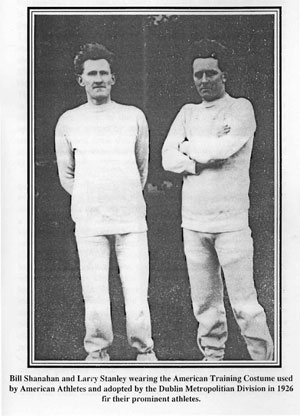 Up to and following the opening ofthe 1920’s his best mark was 5ft. 11ins. Larry Stanley reached 6ft. Jins. at the Tailteann Games of 1924. The most astonishing feat of Shanahan’s career was to clock 11 2. 5 sees. for the 100 yds. during the 1924 Tailtean Games, and in which contestants such as the great Harold Osborne and Kinsey, ofthe Illinois Athletic Club competed. Bill won numerous provincial championships both in Leinster and Munster, and though specialising in the jumps he has also secured hurdles and weight-putting titles at the provincial championships He represented Ireland on four occasions at the international triangular contests, and he was the country’s sole representative in the Decathlon which comprises of an all-round athletic test at the Paris Olympic Games of 1924 at Colombes Stadium where he finished in 19th. position. He failed to get placed in the event but his performance all-round was excellent and several of his attempts
Up to and following the opening ofthe 1920’s his best mark was 5ft. 11ins. Larry Stanley reached 6ft. Jins. at the Tailteann Games of 1924. The most astonishing feat of Shanahan’s career was to clock 11 2. 5 sees. for the 100 yds. during the 1924 Tailtean Games, and in which contestants such as the great Harold Osborne and Kinsey, ofthe Illinois Athletic Club competed. Bill won numerous provincial championships both in Leinster and Munster, and though specialising in the jumps he has also secured hurdles and weight-putting titles at the provincial championships He represented Ireland on four occasions at the international triangular contests, and he was the country’s sole representative in the Decathlon which comprises of an all-round athletic test at the Paris Olympic Games of 1924 at Colombes Stadium where he finished in 19th. position. He failed to get placed in the event but his performance all-round was excellent and several of his attempts
show an improvement on hi·s home form Both he and his friend Stanley made history at this event as Larry Stanley carried our National Flag which was being displayed at the Olympic Games for the first time ever. Also carrying the hopes of lreland at the games was J.J. Ryan from Drumline who competed in the cross country, but he was forced to drop out with the scorching conditions.
1924 Won Munster long jump and hurdles championship; won Co. Dublin high jump and hurdles clearing 6ft. in the former. Won Irish 120 yards hurdles championship
1925 Sceptics had a rude awakening in the Championship of
1926 when he surmounted 6ft I ins. as runner-up to D.M.G.A. comrade, Garda Con O’Connor. At the National championships in June of this year. Shanahan gave a wonderful all-round display, and his performance in the hurdles caused intense excitement, as he and Price (Belfast Unit) raced neck and neck, the Northern, however, beating our representative in last lap. Stanley (holder) did not defend in the high jump, and the laurels passed to O’Connor, 6ft 2 ins. and Shanahan 6ft. l ins.
Bill represented Ireland with real distinction; for he took the Triangular International (Ireland, England, Scotland) high jump laurels of 1926 at Hamden Park, Glasgow, and was runner-up the following year at Fallowfield, Manchester. Shanahan was Pole Jump Champion at 10ft. 3ins. in 1927 and the high jump when he surmounted 6ft 2 ins. to tie for 1’1 place with comrade, Garda Con O’Connor, from the “The Kingdom” It was a duel from first to last between the two. They progressed by two inch stages from 5ft. 6ins. to 6ft. where the first failure occurred. It was surmounted, however, and a hard struggle followed at 6ft. 2ins., O’Connor got first across, and then the imperturbable Ballinure man cleared it like-wise. Both stopped at 6ft 3ins. and suffered alike by an element of ill-luck in at least one try. When Shanahan swung his lathy body and long legs across six feet two the crowds in the stand cheered for minutes at end. It was a delightful exhibition under ideal jumping conditions. All and sundry agreed that Bill’s continued improvements over the years contravened all laid-down athletic standards. The same season he won two Munster Championships in hurdles and javelin at Limerick. Helped to win the “Londonderry” Cup for his club at an event in Belfast tying in the high jump with O’Connor at 6ft. 0 1/4 ins. for 1st place. He cleared 6ft. lins at College Park, Dublin University, at inter-club match.
William Woods of the Gaelic Sportsman newspaper, penned the following verse at the opening of the 1928 season, during which the Olympic Games were due to take place in Amsterdam:-
“The critics say of Shanahan that he will never last,
But we have heard them stating this for many years gone past;
And Bill not only holds his form but jumps on better still,
And proves he is not going down but forging up the hill.
The turning point has yet to come and it may now be near,
And what a fitting thing ‘twould be in such a fine career.
If his best effort were to come upon that fateful day,
To make him world famous and all precious things outweigh!
1928 Bill won Irish high jump championship (5ft 11ms); 3’d m standing high jump at Tailteann Games.
1929 Won Munster high jump championship at 5ft 10ins.
Many notable athletes have showed top form, simultaneouslv in the jumps and hurdles, but on at least two occasions he turned in dual wins, in 1930 at lveagh Grounds, Crumlin, and at Carlow. which no other Irish athlete of any era, excepting Dr. O’C;:dlaghan, could register, and that was to high jump 6ft. and throw a 56lb. thirteen feet over the bar on the same day. And to make the combined performances all the more extraordinary, he had entered his 14 successive season of championship jumping at that time.
Many and many a time did he fail on his first and second try, but there was no other of his era who so consistently surmounted the “fathom” mark and thereabouts at the final attempt, for he remained cool, calculating and unruffled no matter how important the occasion
1930 Second in the pole jump championship; 2nd. place in pole jump Munster inter-county contests, Ennis.
1931 Second in pole jump, Irish championship; tied for 1st place in pole jump Munster inter-county contests, Mallow.
1932 Tied for first place in standing high jump, Tailteann Games (4ft 7ins); second in pole jump at Munster inter-county contest, Clonmel.
1933 Cleared Sft. 11ins at Dungannon sports in high jump; threw the “56” for height (over bar) 13ft. at Mullingar, tied for 1st. place in the pole jump, Munster inter-county Limerick.
In addition to the foregoing, over the years he won a multitude of lesser important events and championship at athletic meetings all over the country, from Antrim to Cork, and from Dublin to Galway.
Bill was the rarest of characters, his witticisms and unfailing good humour usually proving the life of whatever company he travelled with to various sporting venues. He tells of the time he went all the way to Bantry to take home a Munster hop, step and jump title, believing it was there for the asking. Just as the event was due to begin, a heavy shower came, and all entrants, save one, ran for cover. The only remaining sought the permission of the handicapper to do a “bit of practice in his bare feet” with the rain falling in torrents. The practice apparently was beneficial, for the barefooted worthy won the title and was seen riding out of town, bareback, that evening, on a white horse. He was Minihane, from Schull.
Many years ago, Shanahan and Davy Fogarty, from Kilfeacle, went to Dungarvan to compete in an event Before they started they assumed Davy would be first and Bill second in the three standing jumps. Following two rounds of the test, the placing were that way, with the others nowhere, when a small man, wearing a hard hat, came on to the pitch and asked if there was any objection to him competing; Davy and Bill feeling there was nothing in the world to affect their placing, replied, in lordly fashion, that they had no objection. The small man then doffed his hard hat, took off his clothes, having togs underneath, and in his first effort covered 34 feet, to beat both by more than a foot. He was Pat Power of Ballinamult, Co. Waterford.
The following is Shanahans outstanding performances:
Tailtean Games, 1924 – 100 yds. 11 2/5 seconds National Championships, 1927– high jump 6ft. 2ins. Leinster Championships, 1922 – long jump 22ft. 9ins. Kilmallock, 1920 -hop-step-and-jump, 44ft. 9ins. National Championships, 1930 -pole jump, 10ft. 9ins. Waterford, 1928– 56lbs. without follow, 23ft. 0 ins. College Park, 1926 – 120 yds. hurdles, 16 3-5 sees. D.M.G. Sports, 1928 – 56lbs. over bar, 13ft.
National Championships, 1922 -standing long jump, 9ft. 6ins. Tailteann Games, 1924– standing high jump 4ft. 9ins.
Munster Championships, 1927-javelin, 135ft.
The above record, which speaks for itself is possibly unique in the annals of athletics.
His championship medals total more than 80, made up of county, inter-county, and All-Treland.
The athletic field was not the only field in which he distinguished himself. On May 7, 1940, two weeks after his wife’s death, Officer Shanahan was involved in a gun battle in a Dublin street in company with D/0 James McSweeney, as they were bringing State Mails from Pearse St. Post Office in a motor-cycle combination when passing through Holles Street, a motor car cut in, forcing them to the side of the street. As the car passed two Thompson sub-machine guns were thrust out through the windows of its left-hand side, and two bursts were fired at the detectives at almost point-blank range. Both men were wounded. Bill Shanahan taking a burst of half-a-dozen bullets in the chest, and McSweeney getting at least one bullet in his chest.
Wounded as they were, the detectives drew their revolvers and replied to the fire, wounding one of the men whom had alighted from the car. The man was helped back to the car by one of his comrades, and the car then disappeared around the corner into Merrion Square. Their courageous defence of the papers committed to their care is in keeping with the best traditions of loyalty and devotion to duty of any police force in the world, and the State was quick to appreciate their action by instant promotion to sergeant. While the two men were in hospital Eamon De Valera visited them. The Government offered a reward of £5,000 for information leading to the apprehension and conviction of the persons, or any one of the persons, who took part in the murderous attack on two members of the Garda Siochana
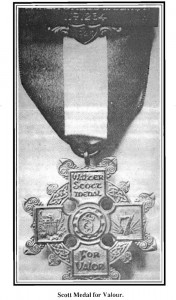 They were also awarded the highest honour in the Land, the Scott Gold Medal for Valour on October 9111 1940. D/Sergeant James McSweeney and D/Sergeant William Shanahan of Dublin Castle were presented their medals by the Minister of Justice, Mr. Gerald Boland, T.D., and on their arrival received the salute from a Guard of Honour under Supt. Deeney, while the Garda Depot Band, under Supt. O’Donnell-Sweeney, struck up the National Anthem. The Commissioner in his address said the recipients had shown themselves to be possessed of the very highest forms of courage. The standard of courage demanded to earn a Scott Medal for Valour was very high, so high that in 1939 no award had been made.
They were also awarded the highest honour in the Land, the Scott Gold Medal for Valour on October 9111 1940. D/Sergeant James McSweeney and D/Sergeant William Shanahan of Dublin Castle were presented their medals by the Minister of Justice, Mr. Gerald Boland, T.D., and on their arrival received the salute from a Guard of Honour under Supt. Deeney, while the Garda Depot Band, under Supt. O’Donnell-Sweeney, struck up the National Anthem. The Commissioner in his address said the recipients had shown themselves to be possessed of the very highest forms of courage. The standard of courage demanded to earn a Scott Medal for Valour was very high, so high that in 1939 no award had been made.
Col Walter Scott, Broadway, New York, presented this medal at a meeting of the Commissioner of the new Irish police force at an International police Conference in New York in 1923. On January 8th 1924, Scott wrote to Gen. O’Duffy confirming his endowment of a Medal for Valour in the Garda Siochana. The medal hangs from a green. white and orange ribbon. There are five panels on the face. The top panel bears the inscription “The Scott Medal” -the name by which the medal will be known, and on the lower panel are the two words signifying the purpose-“For Valour.” On the left and right are the arms of the U.S.A and Ireland, respectively. In the centre are inscribed the intertwined letters G. S. -the initials of the word Garda Siochana. On the back are the arms of the four provinces, and the inscription Garda Siochana Na hEireann. On the centre section of the back will be inscribed the name of the Guard to whom the medal will be awarded. The design is simple but beautiful and reflects great credit on the artist, Mr. J. F. Maxwell, a woodwork teacher. He also designed the Crest for the new police in 1922. The dies for the medal were made in New York and a Dublin firm struck the first gold medal, Johnson’s, jewellers, of Grafton St.
It was Scott’s intention that one medal should be awarded annually to the member of the Garda Siochana who had “specially distinguished himself for valour in the performance of duty. The donor of the Medal for Valour was born in 1861. As a young boy he found a job in the grocery business, probably as a messenger boy, at two dollars a week. By the age of ten he was manager of a small fruit store near Harvard University. At fifteen, he was manager of general wholesalers in New York. He retired in 1932 after 55 years service with the same employer. In his letter to Gen. Duffy confirming the offer to endow a Medal for Valour for the new Irish police force, he wrote: “It was always been a practice of mine to present flowers during life, when one can enjoy their beauty and fragrance”. He sponsored various scholarships throughout the States. When he died in 1935 he was laden with honours at home and abroad. He was a knight of the French Legion of Honour, a member of the Belgian Order of Leopold and held the Silver Grand Cross of Austria. The British Government also decorated him.
The Tipperary Star Newspaper of May 11th’ 1940 carried this piece. “The outrageous attack by gunmen on two Detective Officers in Dublin this week caused pain throughout the country, but nowhere more than in County Tipperary, for one of the victims is a man who has helped to swell Tipperary’s fame on the athletic field. Detective Officer Bill Shanahan is a typical product of Tipperary soil, kindly, genial and humorous, and it has touched many hearts in the county and indeed far beyond, that such a man should be so ruthlessly shot down. The tragedy of the shocking affair, however, has one brightening and redeeming feature and that is the heroism of Detective Officer Shanahan and his comrade. Their courageous defence of the papers committed to their care is in keeping with the best traditions of loyalty and devotion to duty of any police force in the world, and the State was quick to appreciate their action by instant promotion. Both of them, we trust, will recover from their wounds and, some future day, return to duty amid the welcomes and congratulations of their comrades in the Garda.
The Garda Journal December, 1930 stated “No sports meeting is quite complete without Bill Shanahan, but as he is an enigma to, to everyone else, it is beyond the writer to even guess what the next season holds for him. At the conclusion of every season for almost a decade the wise ones have said, “Shanahan cannot stay much longer, ” yet he contests every championship as he did a dozen years ago. It is an extraordinary thing for a man to continue jumping in the neighbourhood of 6ft. for thirteen long years as he has been doing. It’s against all laid down principles.
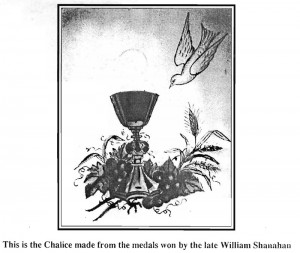 It may be of interest to give an idea of the trophies he has amassed during that lengthy period, in various events, including jumping-high and long, hurdles, sprints, weight events and tug-of-war. He won in excess of five hundred prizes over his thirteen years, and this does not include all his medals. The Shanahan family gave one of his cups to the Shamrock Athletic Club, Dualla in 1982 to be presented annually to the best all-round athlete.
It may be of interest to give an idea of the trophies he has amassed during that lengthy period, in various events, including jumping-high and long, hurdles, sprints, weight events and tug-of-war. He won in excess of five hundred prizes over his thirteen years, and this does not include all his medals. The Shanahan family gave one of his cups to the Shamrock Athletic Club, Dualla in 1982 to be presented annually to the best all-round athlete.
Shanahan was the most versatile and most remarkable of our athletes, Bill died on 29th May 1954 and was buried in Ballinure. His wish was that his medals should be given to the Dominicans, who had them made into a chalice in the shape of the De Burgo Chalice which was a Dominican Chalice of the 18th century and it is now in the Cathedral in Port of Spain, Trinidad.
The author is grateful for the assistance given by the Shanahan family and material found in the following newspaper files, The Evening Herald, Irish Independent, Irish Press, and Evening Mail and Tipperary Star also Pat Dunne, Old Road, Cashel for reproducing the photographs.

